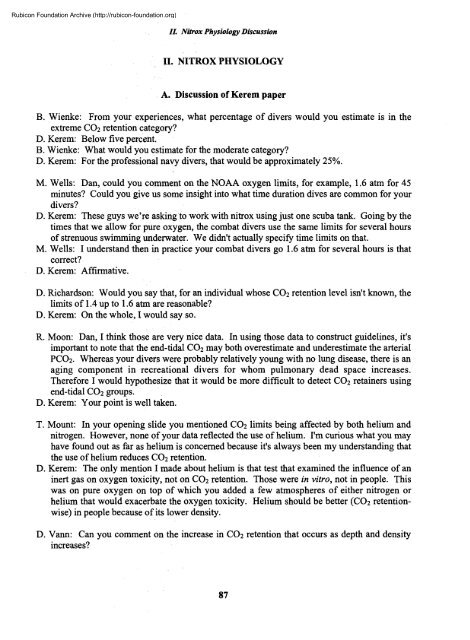Nitrox workshop dings - Divers Alert Network
Nitrox workshop dings - Divers Alert Network
Nitrox workshop dings - Divers Alert Network
Create successful ePaper yourself
Turn your PDF publications into a flip-book with our unique Google optimized e-Paper software.
Rubicon Foundation Archive (http://rubicon-foundation.org)//. <strong>Nitrox</strong> Physiology DiscussionII. NITROX PHYSIOLOGYA. Discussion of Kerem paperB. Wienke: From your experiences, what percentage of divers would you estimate is in theextreme CO2 retention category?D. Kerem: Below five percent.B. Wienke: What would you estimate for the moderate category?D. Kerem: For the professional navy divers, that would be approximately 25%.M. Wells: Dan, could you comment on the NOAA oxygen limits, for example, 1.6 atm for 45minutes? Could you give us some insight into what time duration dives are common for yourdivers?D. Kerem: These guys we're asking to work with nitrox using just one scuba tank. Going by thetimes that we allow for pure oxygen, the combat divers use the same limits for several hoursof strenuous swimming underwater. We didn't actually specify time limits on that.M. Wells: I understand then in practice your combat divers go 1.6 atm for several hours is thatcorrect?D. Kerem: Affirmative.D. Richardson: Would you say that, for an individual whose CO2 retention level isn't known, thelimits of 1.4 up to 1.6 atm are reasonable?D. Kerem: On the whole, I would say so.R. Moon: Dan, I think those are very nice data. In using those data to construct guidelines, it'simportant to note that the end-tidal CO2 may both overestimate and underestimate the arterialPCO2. Whereas your divers were probably relatively young with no lung disease, there is anaging component in recreational divers for whom pulmonary dead space increases.Therefore I would hypothesize that it would be more difficult to detect CO2 retainers usingend-tidal CO2 groups.D. Kerem: Your point is well taken.T. Mount: In your opening slide you mentioned CO2 limits being affected by both helium andnitrogen. However, none of your data reflected the use of helium. I'm curious what you mayhave found out as far as helium is concerned because it's always been my understanding thatthe use of helium reduces CO2 retention.D. Kerem: The only mention I made about helium is that test that examined the influence of aninert gas on oxygen toxicity, not on CO2 retention. Those were in vitro, not in people. Thiswas on pure oxygen on top of which you added a few atmospheres of either nitrogen orhelium that would exacerbate the oxygen toxicity. Helium should be better (CO2 retentionwise)in people because of its lower density.D. Vann: Can you comment on the increase in CO2 retention that occurs as depth and densityincreases?87
















